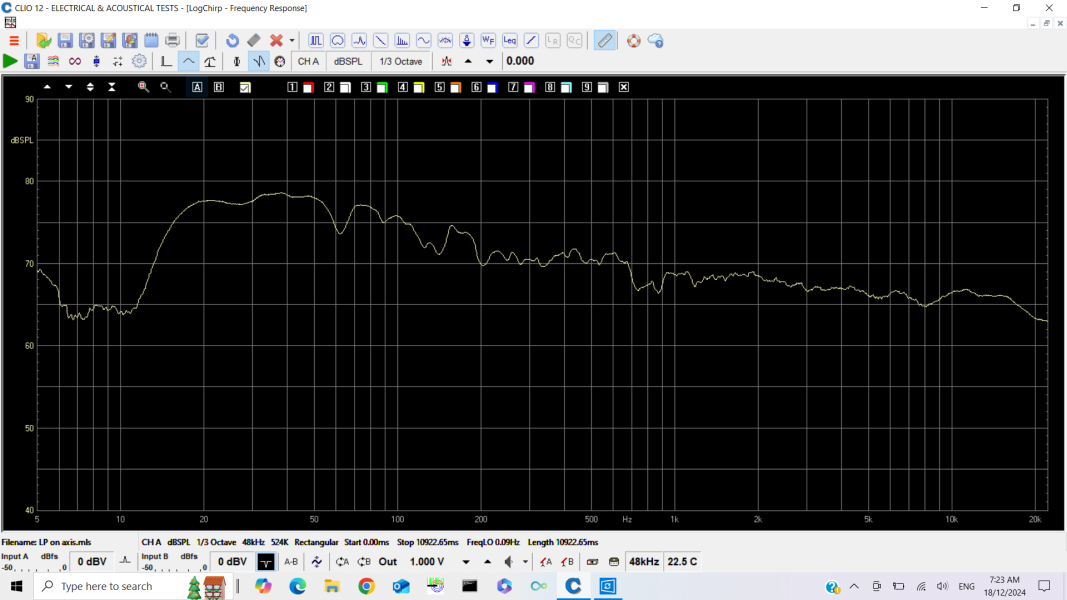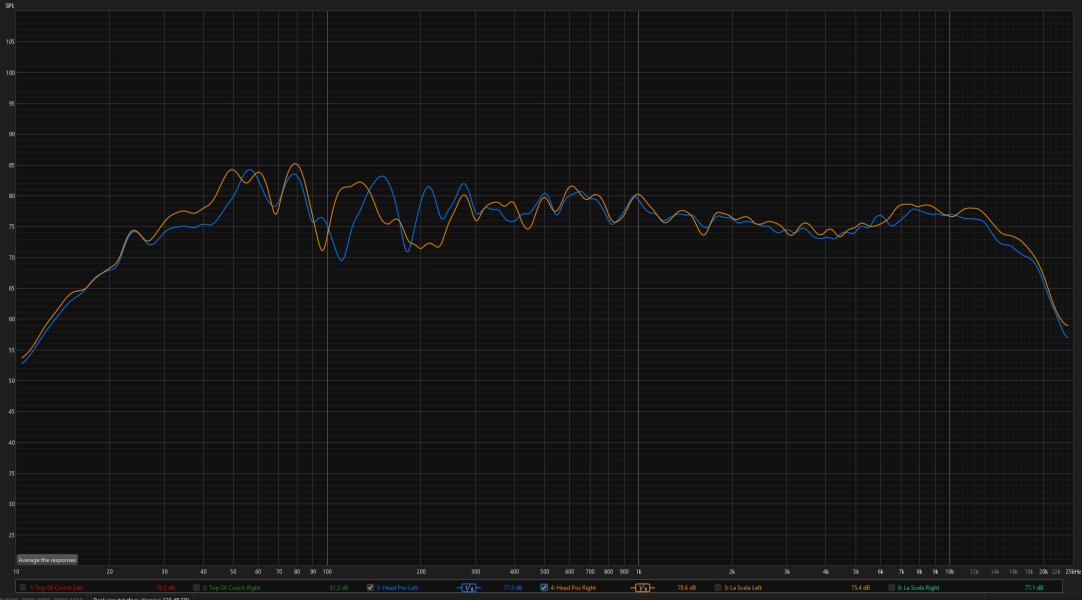That's an exceptional response, congrats! Is that with any EQ or subs?View attachment 141594
Draw a line from 100 Hz to 10 kHz. The shallow valley centered at 2kHz is very much intended. Closed box below 45 Hz, dipole above.
Post Your Frequency Response Curve!
- Thread starter Ron Resnick
- Start date
You are using an out of date browser. It may not display this or other websites correctly.
You should upgrade or use an alternative browser.
You should upgrade or use an alternative browser.
Lots of EQ. 
Those three way dipoles first need flattening of the driver passbands, and the subwoofers too (each has 2 12" in a 40 l box). Then it’s the crossovers, and finally room correction (done manually!) and frequency response trim to taste.
The pic shows L/R system frequency response in the listening position.
Those three way dipoles first need flattening of the driver passbands, and the subwoofers too (each has 2 12" in a 40 l box). Then it’s the crossovers, and finally room correction (done manually!) and frequency response trim to taste.
The pic shows L/R system frequency response in the listening position.
Last edited:
Or subwoofers and / or diaphragmatic absorbers.If you measure at the corners of your room and they also have 28Hz peaks, you could buy PSI AAVA C20 or C214 and place them at those corners to reduce the peaks by a bit but more importantly reduce the resonance at 28Hz by quite a bit more. It is likely the resonance is blurring all frequencies slightly in music that hits that note. You probably don’t even need to use REW to do a full measurement of the corners. Because you’re just trying to see whether the 28Hz is mostly coming from the corners, you can play pink noise and just have an iPhone app running AudioTools to see what the frequency response looks like at the corners.
Another option would be to replace the GIK corner traps with the Vicoustic Mega Bass Trap XXL. But these traps are really really huge. Hence PSI AAVA is more practical?
Kjetil,View attachment 141594
Draw a line from 100 Hz to 10 kHz. The shallow valley centered at 2kHz is very much intended. Closed box below 45 Hz, dipole above.
Very nice !
That looks a bit similar to where I have ended up. I felt a bit guilty boosting the bass that much (impure
What improvement did you get with that broad dip
Phil

It’s a very old BBC trick that «moves» the listener some rows backwards in the (artificial) concert hall.
I had not heard of that .. I listen to mainly jazz, chamber and folk so quite like the intimacy of that type of recording .. I based that part of my curve on the linkwitz roll off .. he has a plausible theory as to why it worksIt’s a very old BBC trick that «moves» the listener some rows backwards in the (artificial) concert hall.
I am playing with a second complete digital xover system and will try that dip
Cheers
Phil
Here you go. These are head position, which were the smoothest in the high end, blue left, orange right. The step response is after we corrected the polarity from your DAC. Great sounding room!@Ampexed
Hey!
I just noticed your room measurements posted here and was wondering if you still have the last measurements you took at my place. I’d be interested to see them as I haven’t set up my MacBook Pro with REW.


Thanks for that- I was hoping you still had the files! I’m in no way the expert here but it’s good to see the measurements and to be able to compare them against what others have going on.Here you go. These are head position, which were the smoothest in the high end, blue left, orange right. The step response is after we corrected the polarity from your DAC. Great sounding room!
View attachment 141748
View attachment 141749
They are pretty good indeed .. odd that channels are different around the 200 hz mark .. that looks like the dreaded "foor bounce" but you would expect that to be very symmetrical .. must be other asymmetries in the roomThanks for that- I was hoping you still had the files! I’m in no way the expert here but it’s good to see the measurements and to be able to compare them against what others have going on.
It would be worthwhile getting everything as symmetrical as possible ( as I am sure you know)
It really helps imaging
I would suspect that it is from an alcove at the right-rear of the room. Nothing can be done about that!They are pretty good indeed .. odd that channels are different around the 200 hz mark .. that looks like the dreaded "foor bounce" but you would expect that to be very symmetrical .. must be other asymmetries in the room
It would be worthwhile getting everything as symmetrical as possible ( as I am sure you know)
It really helps imaging
View attachment 141973
Speaker in-room a room's RT response (RT within 23%).
And speaker itself (red) vs in-room (green) - shows what room adds or takes.
View attachment 141976
Welcome to the forum … Perhaps a few words about your transducers and associated system would lend a little context behind your response graphs , which look pretty well btw.
The room typical listening/living/home cinema transformer, professionaly treated with Jocavi Acoustic panels https://jocavi.net/portfolio/DemoLivingRoom/227andWelcome to the forum … Perhaps a few words about your transducers and associated system would lend a little context behind your response graphs , which look pretty well btw.
These speakers measured there are custom built project based on SB Textreme drivers with Beryllium dome tweeter. Not the ones what on Jocavi project page, smaller version - Rinjani Textreme Beryllium by StereoArt : image attached .
Attachments
Good chioce the same sb drivers that rockport use for the speakersThe room typical listening/living/home cinema transformer, professionaly treated with Jocavi Acoustic panels https://jocavi.net/portfolio/DemoLivingRoom/227and
These speakers measured there are custom built project based on SB Textreme drivers with Beryllium dome tweeter. Not the ones what on Jocavi project page, smaller version - Rinjani Textreme Beryllium by StereoArt : image attached .
They have same looking cones, but drivers are not the same. I feel it is better midwoofersGood chioce the same sb drivers that rockport use for the speakers
Which one satori you use the mw19tx4 or other.?They have same looking cones, but drivers are not the same. I feel it is better midwoofers
This project was based on 2x MW16TX-8.Which one satori you use the mw19tx4 or other.?
you sure about that, I was told at axpona that they design and build there own driversGood chioce the same sb drivers that rockport use for the speakers
Rockport use wo24x & mw 13tx or 16 in the lyra i don't know exactly. Really good drivers.This project was based on 2x MW16TX-8.
@Porsche
That's what many manufacturers claim
Similar threads
- Replies
- 4
- Views
- 4K
- Replies
- 26
- Views
- 26K
- Replies
- 85
- Views
- 67K
- Replies
- 4
- Views
- 37K
- Replies
- 400
- Views
- 158K
| Steve Williams Site Founder | Site Owner | Administrator | Ron Resnick Site Owner | Administrator | Julian (The Fixer) Website Build | Marketing Managersing |





